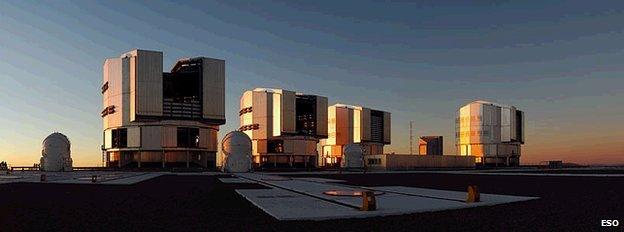Milky Way's black hole to eat planet-forming cloud
- Published

In this artist's impression, the protoplanetary disc is being pulled into the yawning gape of SgrA*
A young star and its planet-forming cloud are being pulled towards the huge black hole at the centre of our galaxy, astronomers say.
Like other galaxies, the Milky Way hosts a black hole, known as Sagittarius A* (SgrA*), at its centre.
SGrA* dislodged the star from its original orbit within a ring of young suns circling the black hole.
The disc of gas and dust will be devoured before it can evolve into a solar system.
The research by a team at the Harvard-Smithsonian Center for Astrophysics in Cambridge, US, is published in Nature Communications journal.
Earlier this year, researchers reported seeing a cloud, external of ionised gas and dust falling in towards SgrA*.
They suggested that it formed when gas streaming from two nearby stars collided, like wind-blown sand gathering into a dune.
Astronomers Ruth Murray-Clay and Abraham Loeb have come up with a different explanation: that the cloud is a proto-planetary disc surrounding a low-mass star.
Newborn stars retain a surrounding disc of gas and dust for millions of years. If one such star were to dive toward our galaxy's central black hole, radiation and gravitational tides would rip apart the surrounding matter in just a few years.
The star is now hurtling towards the black hole on an elliptical orbit.
While the star itself is too small to be directly observed, the proto-planetary dust cloud accompanying it is being disrupted on the way, and it is this debris that the researchers were able to detect.

The cloud of gas and dust was discovered using the Very Large Telescope
"This unfortunate star got tossed toward the central black hole. Now it's on the ride of its life," said Dr Murray-Clay.
As the young sun continues to plummet towards the black hole over the next year, more of the disc's outer material will be torn away. The stripped gas will swirl into the yawning black hole. Friction will heat it to high enough temperatures that it will glow in X-rays.
But while the planetary cloud is heading for destruction, the star is likely to survive.
"The tidal forces from the black hole are strong enough to strip gas away from the star but not strong enough to pull the star itself apart," Dr Murray-Clay told BBC News.
"The same sort of forces that generate ocean tides are at work here. Ocean tides happen when the oceans are pulled away from the Earth a little bit by the Moon. In our case, the black hole is generating such strong tidal forces that they pull a large fraction of the disc entirely away from the star.
"The inner portion of the disc will survive - gas close to the young star is held more tightly since it is deeper in the star's gravitational well."
The results are interesting because the centre of the Milky Way should be a very inhospitable place to try to form a planet.
Stars crowd each other as they zip through space while exploding stars unleash shock waves and bathe the region in intense radiation. The powerful gravitational forces from a supermassive black hole twist and warp the fabric of space itself.
The research suggests, contrary to received wisdom, that planets can still form in this cosmic war zone.
Although this protoplanetary disc is being destroyed, the stars that remain in the ring can hold onto their planet-forming clouds. This means they could form planets despite the hostile surroundings.
"It's fascinating to think about planets forming so close to a black hole," said Abraham Loeb.
- Published14 December 2011
- Published12 October 2011
- Published12 August 2011